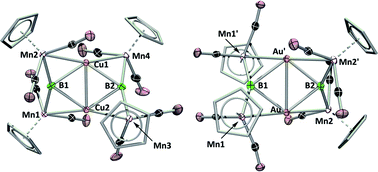Treatment of an anionic dimanganaborylene complex ([{Cp(CO)2Mn}2B]−) with coinage metal cations stabilized by a very weakly coordinating Lewis base (SMe2) led to the coordination of the incoming metal and subsequent displacement of dimethylsulfide in the formation of hexametalladiborides featuring planar four-membered M2B2 cores (M = Cu, Au) comparable to transition metal clusters constructed around four-membered rings composed solely of coinage metals. The analogies between compounds consisting of B2M2 units and M4 (M = Cu, Au) units speak to the often overlooked metalloid nature of boron. Treatment of one of these compounds (M = Cu) with a Lewis-basic metal fragment (Pt(PCy3)2) led to the formation of a tetrametallaboride featuring two manganese, one copper and one platinum atom, all bound to boron in a geometry not yet seen for this kind of compound. Computational examination suggests that this geometry is the result of d10–d10 dispersion interactions between the copper and platinum fragments.

